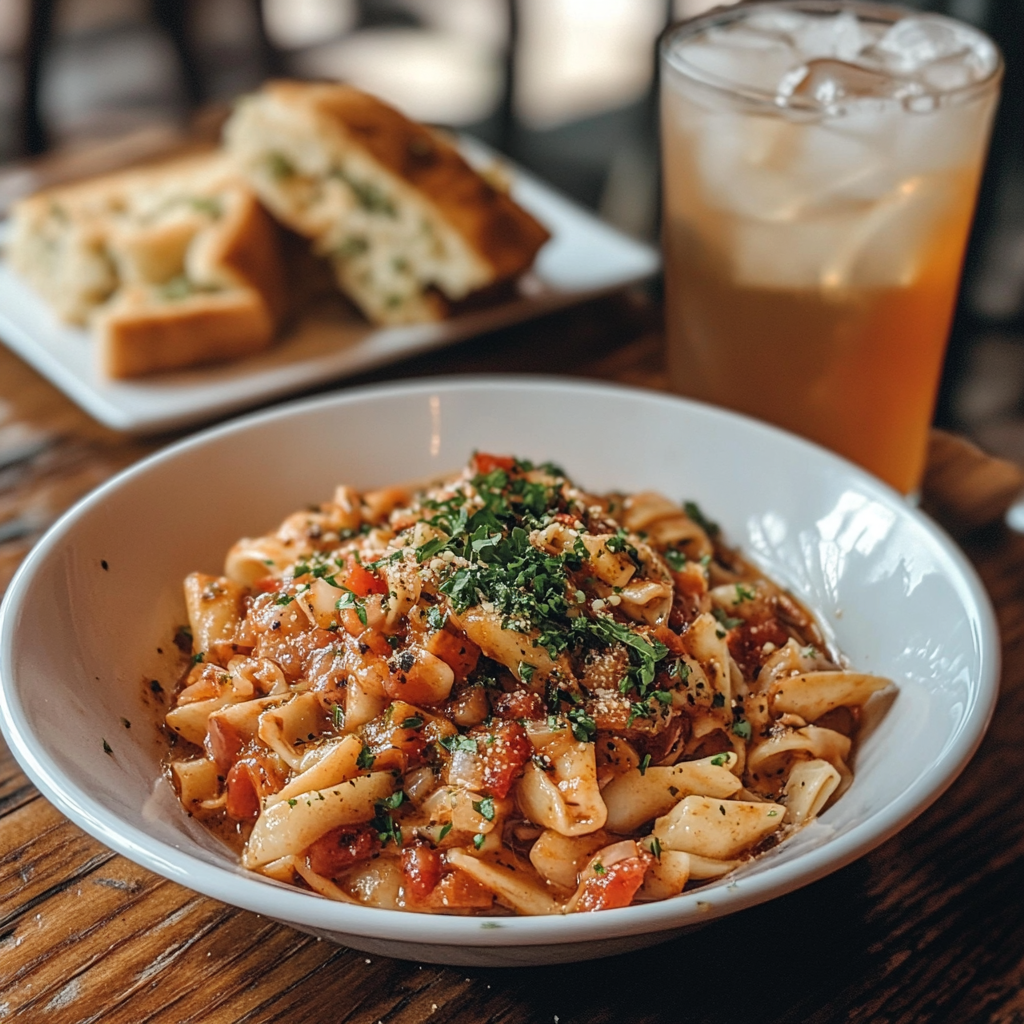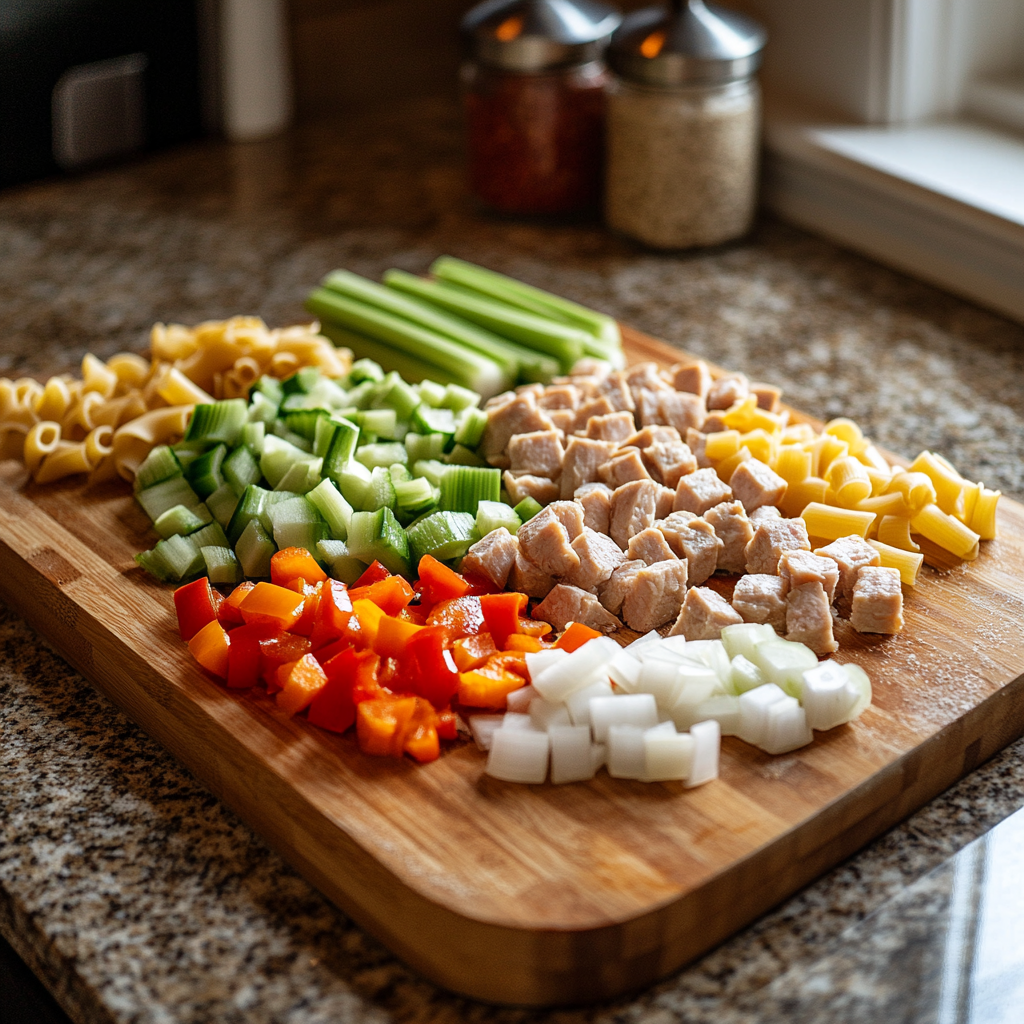Discover the ideal water-to-noodle ratio for pastalaya to perfect this Cajun-inspired dish. Learn cooking tips and techniques for delicious results.

Introduction
When it comes to pastalaya, a Cajun-Italian fusion of bold flavors and hearty ingredients, getting the liquid-to-pasta ratio right is key to achieving a dish that’s both flavorful and perfectly cooked. This article explores everything you need to know about the water-to-noodle ratio for pastalaya, delving into its history, ingredients, and practical cooking tips to ensure culinary success. Let’s jump in and uncover the secrets to mastering pastalaya.
Understanding Pastalaya
Let me revise the sections to improve the distribution of the water-to-noodle ratio for pastalaya keyphrase and its synonyms.
Origins of Pastalaya
pastalaya , as the name suggests, is a creative twist on traditional jambalaya—a celebrated dish in Cajun and Creole cuisine. However, instead of rice, pasta takes center stage, offering a unique texture and flavor. This dish, which relies on the right liquid-to-noodle ratio, is steeped in Southern traditions, born from communities that thrived on hearty meals brimming with proteins, vegetables, and seasonings. Its evolution reflects both the cultural diversity and culinary ingenuity of the region, blending Italian influence into its Cajun roots.
Key Ingredients in Pastalaya
The building blocks of pastalaya are simple yet versatile, and the water-to-noodle ratio plays a critical role in bringing these ingredients together. Proteins such as chicken, sausage, or shrimp provide a robust flavor base, while aromatic vegetables like onions, bell peppers, and celery—known as the “holy trinity”—enhance its depth. The inclusion of pasta, whether spaghetti, penne, or rotini, makes the liquid-to-pasta ratio essential for achieving the perfect texture. Finally, the liquid, typically a combination of broth and seasonings, ties everything together into a cohesive, savory masterpiece, ensuring the noodles cook evenly and absorb the dish’s rich flavors.

Importance of Liquid-to-Pasta Ratio
Why is the water-to-noodle ratio for pastalaya such a big deal? Too much liquid can leave your pastalaya soupy, while too little risks undercooking the pasta or even burning the dish. This ratio is crucial because the balance affects not only the dish’s texture but also its flavor. As the pasta cooks, it absorbs the spiced broth, which depends on the right noodle-to-liquid proportion. Mastering this balance is essential for delivering a dish that’s neither too dry nor overly wet but just right—every single time.
Determining the Ideal Water-to-Noodle Ratio for Pastalaya
Mastering the water-to-noodle ratio for pastalaya is crucial to creating a balanced, flavorful dish. Achieving the right consistency depends on understanding the liquid-to-pasta ratio for pastalaya and adjusting it based on factors like pasta type, cooking method, and serving size. Let’s explore how to perfect this fundamental element.
Standard Liquid-to-Pasta Ratio for Pastalaya
In most pastalaya recipes, the recommended best noodle-to-liquid proportion for pastalaya is approximately 2 cups of liquid for every 1 cup of dry pasta. This ensures the pasta absorbs the broth while maintaining the ideal noodle consistency in pastalaya. The liquid, often a mix of chicken stock and seasonings, enhances the dish’s flavor while allowing the pasta to cook evenly.
Variations in this ratio occur based on preferences. For example:
- Saucier pastalaya: Add ¼ to ½ cup more liquid to achieve a brothier texture.
- Dryer pastalaya: Stick closely to the standard ratio to ensure the liquid is fully absorbed.
Factors Influencing the Ratio
How the Type of Pasta Affects the Water-to-Noodle Ratio for Pastalaya
The type of pasta you select significantly impacts the pastalaya cooking ratio:
- Spaghetti or linguine: These long, thin noodles absorb liquid quickly, often requiring precise measurements to avoid mushiness.
- Penne or rigatoni: Their tubular shapes and ridges capture liquid within, sometimes requiring slightly more broth.
- Rotini or fusilli: Spiraled shapes absorb seasonings while maintaining the optimal liquid-to-pasta ratio for pastalaya.
- Smaller pastas, like macaroni, need less liquid to prevent overcooking.
Choosing the right pasta type ensures your dish achieves the desired noodle consistency in pastalaya.
Adjusting the Liquid-to-Pasta Ratio Based on Desired Noodle Consistency in Pastalaya
Your preference for a saucy or dry pastalaya influences the best noodle-to-liquid proportion for pastalaya.
- For a saucy consistency: Increase the liquid slightly, ensuring the pasta has more to absorb.
- For a firmer texture: Adhere strictly to the standard ratio and monitor closely to avoid overhydration.
The water-to-noodle ratio for pastalaya can be fine-tuned based on how you envision the final dish.
How Cooking Methods Change the Pastalaya Cooking Ratio
The method and equipment you use also affect the pastalaya cooking ratio:
- Stovetop cooking: Requires a slightly higher ratio due to evaporation. Stir frequently to prevent sticking.
- Instant Pot or pressure cooker: Use a reduced liquid-to-pasta ratio for pastalaya (e.g., 1.5 cups liquid per cup of pasta), as less moisture escapes.
- Slow cooker: Requires additional liquid added incrementally over time, ensuring the pasta absorbs evenly.
Understanding your equipment is key to managing the water-to-noodle ratio for pastalaya.
Scaling the Water-to-Noodle Ratio for Pastalaya to Different Serving Sizes
Scaling the water-to-noodle ratio for pastalaya is simple with these tips:
- For larger groups: Multiply the pasta and liquid proportionately, sticking to the standard ratio (e.g., 4 cups pasta = 8 cups liquid).
- For smaller portions: Measure carefully, as even small deviations in the pastalaya cooking ratio can affect the dish’s texture.
Also, consider the cookware’s surface area—wider pots lead to faster evaporation and may need additional liquid. These adjustments ensure the perfect noodle consistency in pastalaya every time.
Practical Application and Cooking Tips
Cooking pastalaya to perfection requires careful attention to detail, from preparing your ingredients to monitoring the consistency of the dish. Here’s a step-by-step guide that simplifies the process while highlighting tips to avoid common mistakes.
Preparing the Ingredients
The foundation of a great pastalaya starts with well-prepared ingredients. Begin by:
- Chopping vegetables: Dice onions, bell peppers, and celery—the “holy trinity” of Cajun cooking—into uniform pieces to ensure even cooking and distribution of flavor.
- Selecting proteins: Choose high-quality chicken, sausage, or shrimp, or a combination of these, depending on your preference. Cut proteins into bite-sized pieces for easy cooking and serving.
- Prepping the liquid: Use chicken or vegetable broth for the liquid base. To enhance the flavor, consider simmering the broth with spices like thyme, paprika, and bay leaves before adding it to the dish.
Having all your ingredients ready before you start cooking ensures a smoother process and minimizes stress.
Cooking Meats and Vegetables
- Heat your pot: Use a heavy-bottomed pot or Dutch oven to ensure even heat distribution and prevent sticking.
- Brown the proteins: Start by browning the sausage and chicken in a small amount of oil to develop rich, caramelized flavors. Remove the cooked proteins and set them aside.
- Sauté the vegetables: In the same pot, sauté the chopped onions, bell peppers, and celery. This step extracts their natural sweetness and enhances the overall flavor.
Incorporating Pasta and Liquid
Once the vegetables are tender, it’s time to combine the main components:
- Return proteins to the pot: Add the browned meats back into the pot, along with any juices that have accumulated.
- Add pasta and liquid: Measure your pasta and liquid according to the ideal water-to-noodle ratio. Pour the liquid over the pasta, ensuring it is evenly submerged.
- Season generously: Add your favorite Cajun seasonings, salt, and pepper. Stir everything well to combine.
Monitoring and Adjusting Consistency
Simmer the pastalaya over medium heat, stirring occasionally to prevent sticking. Check the pasta’s texture frequently to avoid overcooking. If the liquid absorbs too quickly, add small amounts of broth to maintain the right consistency.
Common Mistakes to Avoid
- Overcooking the pasta: Cooking for too long or at too high a heat can result in mushy noodles. Stick to the recommended cooking times.
- Using the wrong ratio: Too much liquid can make the dish soupy, while too little risks unevenly cooked pasta. Measure carefully.
- Skipping the browning step: Failing to brown the proteins can result in a less flavorful dish.
- Neglecting to stir: Stir occasionally to prevent the pasta from sticking to the bottom of the pot.
Enhancing Flavor and Serving Suggestions
A well-made pastalaya can stand on its own as a satisfying dish, but balancing the liquid-to-pasta ratio for pastalaya and incorporating complementary sides can elevate it to new culinary heights. By selecting the right seasonings and pairing your dish thoughtfully, you’ll ensure every bite highlights the perfect pastalaya cooking ratio.
Selecting the Right Seasonings to Enhance the Liquid-to-Pasta Ratio for Pastalaya
Seasoning is the heart and soul of any Cajun dish, and pastalaya is no exception. The right spices not only enhance flavor but also integrate seamlessly with the best noodle-to-liquid proportion for pastalaya:
- Cajun spices: A mix of paprika, cayenne pepper, garlic powder, onion powder, and dried herbs like thyme and oregano adds authentic flavor without overwhelming the dish. This blend works perfectly within the pastalaya cooking ratio by complementing the liquid and pasta balance.
- Customizing spice levels: Adjust the heat level by varying cayenne or chili powder to suit your preferences. For a milder option, smoked paprika provides depth without overpowering the noodle consistency in pastalaya.
- Boosting umami: Add a splash of Worcestershire sauce or soy sauce to the broth. These ingredients blend with the liquid and pasta, creating a harmonious flavor profile that enhances the liquid-to-pasta ratio for pastalaya.
These seasonings not only enhance the dish’s flavor but also highlight the balance achieved through careful consideration of the water-to-noodle ratio for pastalaya.
Adding Vegetables and Proteins to Balance the Liquid-to-Pasta Ratio for Pastalaya
While traditional pastalaya recipes highlight the “holy trinity” of onions, celery, and bell peppers alongside a primary protein, there’s plenty of room for customization. The right additions not only boost flavor but also help maintain the best noodle-to-liquid proportion for pastalaya.
- Vegetables: Incorporate mushrooms, zucchini, or spinach for extra nutrition and texture. These vegetables blend seamlessly into the dish, absorbing the spiced broth and ensuring a balanced pastalaya cooking ratio. For example, mushrooms absorb flavors well without disrupting the liquid-to-pasta ratio for pastalaya.
- Proteins: Experiment with shrimp, which adds a briny sweetness, or turkey sausage for a leaner option. Both pair wonderfully with the noodle consistency in pastalaya, as they complement the dish’s texture while ensuring the pasta cooks evenly. Tofu can also be a great alternative, offering a plant-based protein option that works well within the pastalaya cooking ratio.
By thoughtfully adding vegetables and proteins, you can create a dish that not only enhances flavor but also maintains the perfect water-to-noodle ratio for pastalaya. These adjustments ensure the final dish is versatile, satisfying, and perfectly balanced for any occasion.
Serving Suggestions and Accompaniments
Pairing pastalaya with the right sides enhances the flavors while complementing the texture created by the water-to-noodle ratio for pastalaya. Whether you’re aiming for a full-course meal or a simple accompaniment, these options are sure to elevate your dish:
- Crusty bread: A warm baguette or garlic bread is perfect for soaking up the rich broth that results from the best noodle-to-liquid proportion for pastalaya.
- Fresh salads: Serve with a crisp green salad tossed in a light vinaigrette to balance the hearty flavors of your pastalaya cooking ratio.
- Roasted vegetables: Side dishes like roasted asparagus, carrots, or Brussels sprouts offer a complementary sweetness and crunch, blending seamlessly with the liquid-to-pasta ratio for pastalaya.
- Cornbread: For a Southern twist, pair your dish with moist, buttery cornbread. It’s the perfect match for the savory flavors and ideal noodle consistency in pastalaya.
Don’t forget to garnish your pastalaya with freshly chopped parsley or green onions. This simple touch adds a pop of color and a fresh finish that highlights the careful balance of your pastalaya cooking ratio.
Frequently Asked Questions (FAQs)
Cooking pastalaya raises several questions, especially when aiming to perfect the water-to-noodle ratio for pastalaya. Whether you’re fine-tuning your pastalaya cooking ratio or experimenting with different pasta types, these answers will help you achieve delicious results every time.
What is the recommended water-to-noodle ratio for pastalaya
The ideal liquid-to-pasta ratio for pastalaya is generally 2 cups of liquid per 1 cup of dry pasta. This ensures the pasta absorbs just the right amount of flavorful broth without becoming overly soft or leaving the dish dry. Adjustments can be made based on your desired consistency:
- For saucy pastalaya: Add ¼ to ½ cup more liquid to enhance the broth’s presence.
- For a firmer noodle consistency in pastalaya: Stick to the standard measurement, monitoring closely to prevent overhydration.
Can I use different types of pasta in pastalaya?
Absolutely! Different pasta types influence the water-to-noodle ratio for pastalaya, depending on their shapes and absorption rates. Here’s how some common varieties stack up:
- Spaghetti or linguine: Long and thin, these absorb liquid quickly, making the noodle-to-liquid proportion critical to prevent mushiness.
- Penne or rigatoni: Their ridged surfaces trap sauce, often requiring a slightly higher liquid amount.
- Rotini or fusilli: These spiraled shapes capture seasonings well while maintaining the ideal pastalaya cooking ratio.
- Gluten-free or whole wheat pasta: These options may absorb liquid at different rates, so adjust by starting with slightly less liquid and adding more gradually.
For best results, pair your pasta type with a liquid amount that ensures even cooking and the desired texture.
How can I prevent my pastalaya from becoming too mushy?
Preventing mushy pasta begins with maintaining the proper water-to-noodle ratio for pastalaya. Follow these tips:
- Stick to precise measurements: Using too much liquid can overhydrate the pasta, disrupting the best noodle-to-liquid proportion.
- Monitor cooking times: Residual heat will continue to soften the pasta even after cooking stops, so avoid leaving it on the heat too long.
- Stir occasionally: This distributes the liquid evenly and helps maintain a balanced noodle consistency in pastalaya.
Starting with less liquid and adding more as needed gives you better control over the final texture.
What are common mistakes to avoid when cooking pastalaya?
Here are some common errors to watch for when managing the pastalaya cooking ratio:
- Skipping the browning stage: This step builds flavor, so don’t miss it.
- Overloading with liquid: Too much liquid can turn your pastalaya soupy. Stick to the recommended liquid-to-pasta ratio for pastalaya.
- Neglecting to stir: Stirring ensures the noodles cook evenly and absorb the broth correctly.
- Overcooking the pasta: This can happen quickly if you don’t monitor the water-to-noodle ratio closely.
Avoiding these mistakes ensures a flavorful, perfectly balanced dish.
How can I adjust the recipe for larger or smaller groups?
Scaling the water-to-noodle ratio for pastalaya is straightforward when cooking for different group sizes:
- For larger groups: Multiply the pasta and liquid amounts proportionately while maintaining the same ratio (e.g., 4 cups of pasta = 8 cups of liquid).
- For smaller servings: Halve the measurements and measure accurately to avoid over- or under-hydrating the noodles.
Remember, the pot size matters too—a wider pot may require more liquid to offset evaporation, ensuring the noodles cook evenly in any batch size.
What side dishes pair well with pastalaya?
The perfect sides enhance the flavors of your pastalaya while complementing its texture. Here are a few options:
- Garlic bread or cornbread: Both pair beautifully with the rich broth created by the liquid-to-pasta ratio for pastalaya.
- Fresh salads: A crisp green salad with a tangy vinaigrette balances the hearty flavors.
- Roasted vegetables: Roasted carrots, Brussels sprouts, or asparagus add sweetness and crunch, completing your meal.
Paired with the ideal pastalaya cooking ratio, these sides create a well-rounded dining experience your guests will love.
